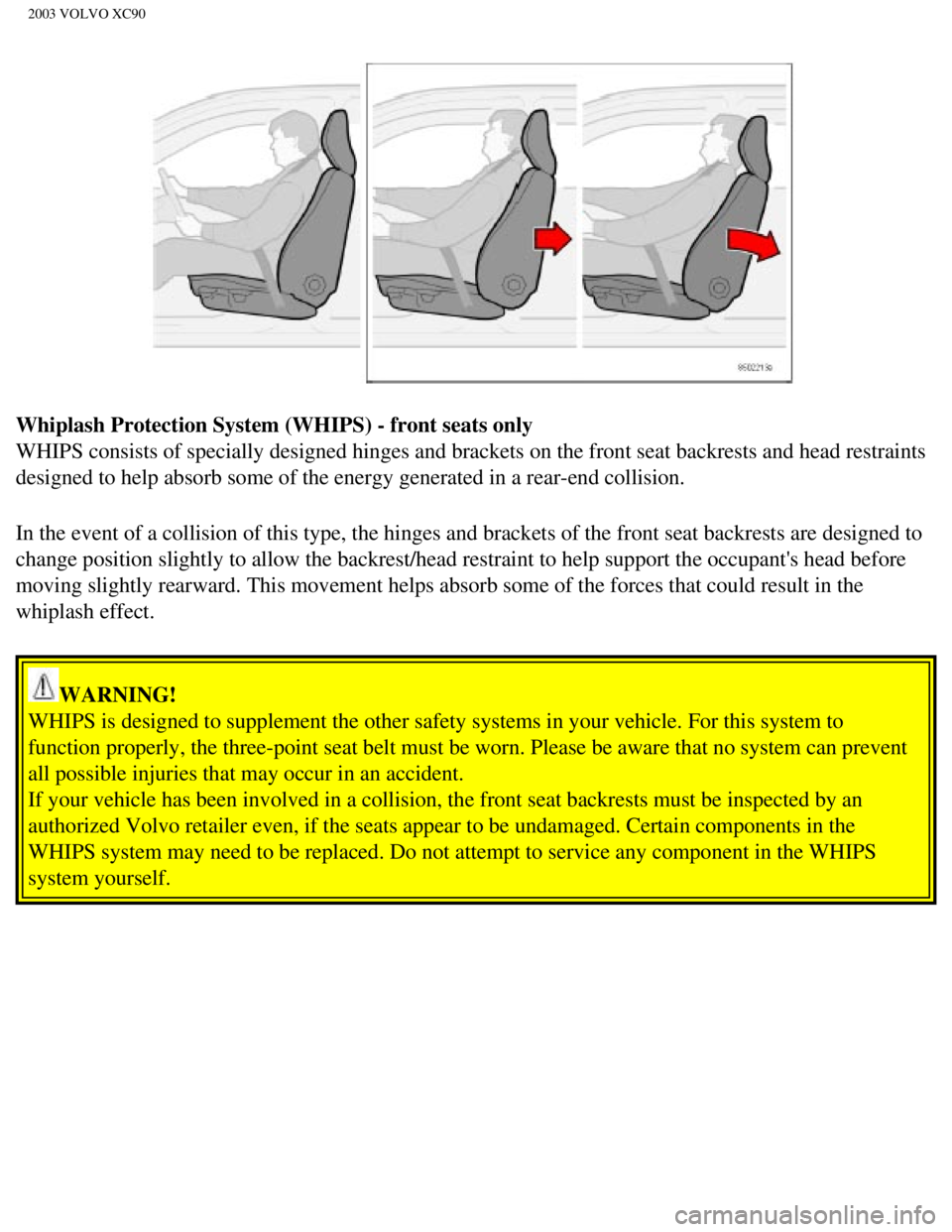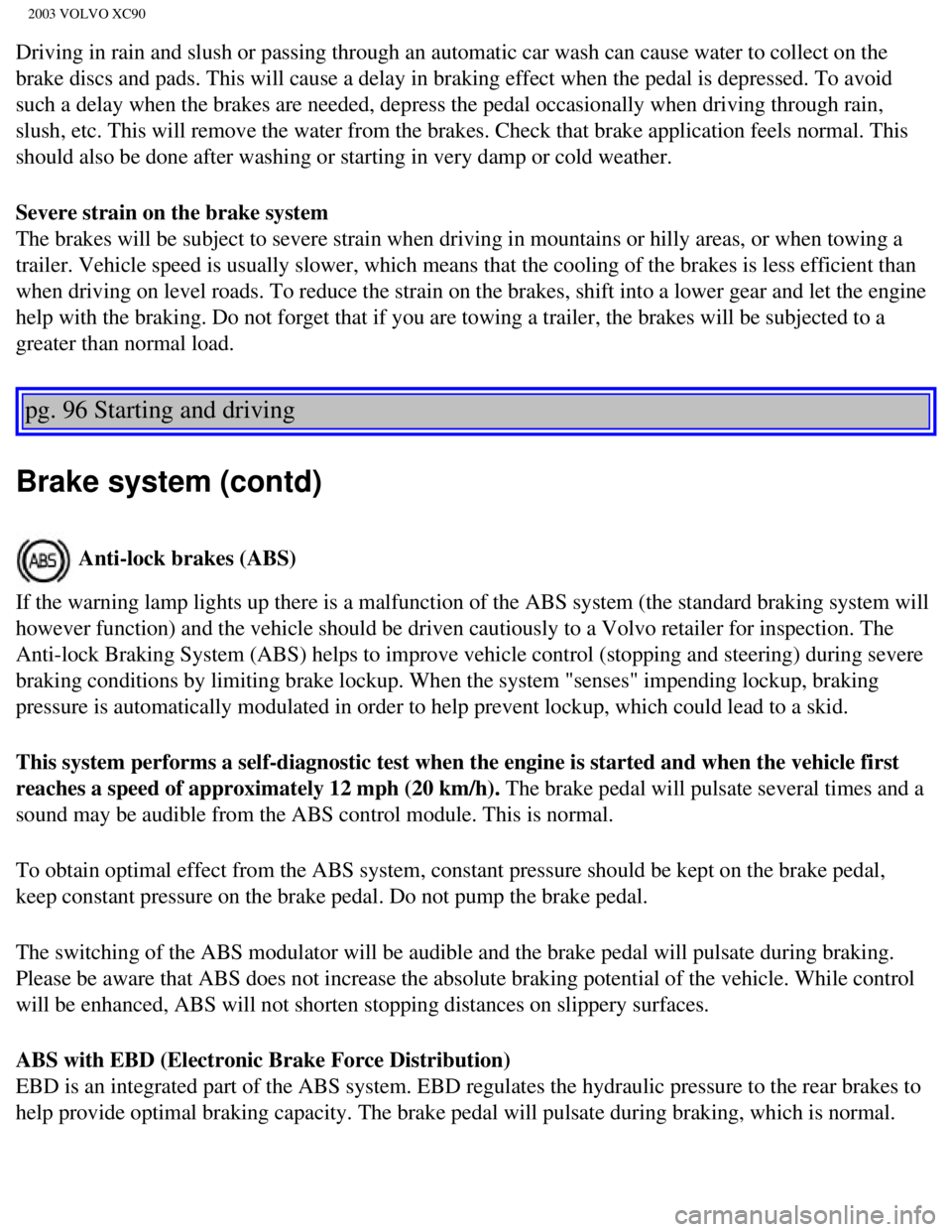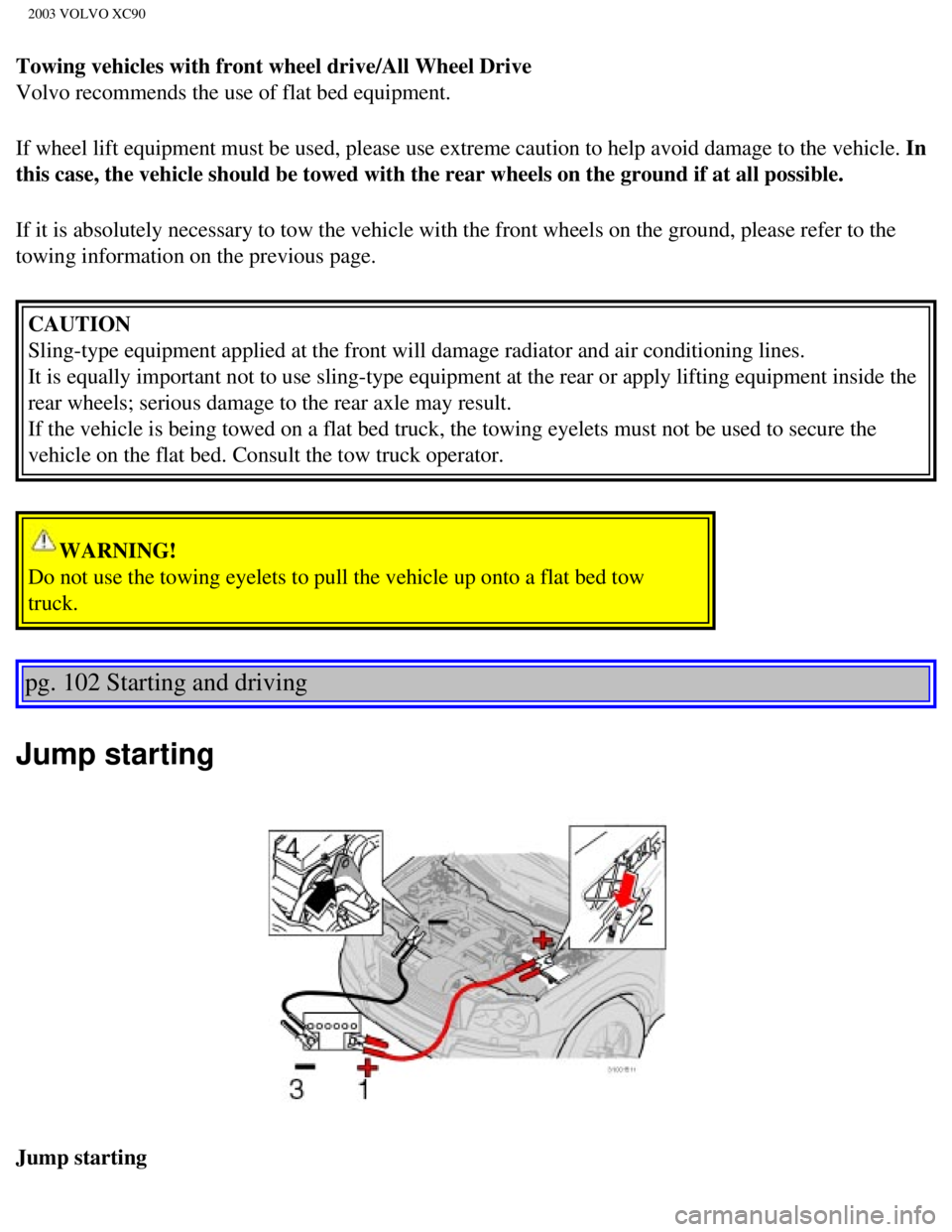2003 VOLVO XC90 ABS
[x] Cancel search: ABSPage 2 of 242

2003 VOLVO XC90
instructions and maintenance requirements/recommendations in this manual\
. We also urge you and your
passengers to wear seat belts at all times in this (or any other) auto\
mobile. And, of course, please do not operate
a vehicle if you may be affected by alcohol, medication or any impairmen\
t that could hinder your ability to
drive.
Your Volvo is designed to meet all applicable safety and emission standa\
rds, as evidenced by the certification
labels attached to the driver's door opening and on the left wheel housi\
ng in the engine compartment.
For further information please contact your retailer, or:
In the USA:
Volvo Cars of North America
Customer Relations
P.O. Box 914
Rockleigh, New Jersey 07647-0914
800-458-1552
In Canada:
Volvo Cars of Canada Ltd.
175 Gordon Baker Road
North York, Ontario M2H 2N7
800-663-8255
General information
Shiftlock
When your car is parked, the gear selector is locked in the (P)ark position. To release the selector from this
position, turn the ignition key to position II (or start the engine), \
depress the brake pedal, press the button on the
front side of the gear selector knob and move the selector from (P)ark\
.
Keylock (automatic transmission)
When you switch off the ignition, the gear selector must be in the (P)ark position before the key can be
removed from the ignition switch.
Anti-lock Brake System (ABS)
The ABS system in your car performs a self-diagnostic test when the vehi\
cle first reaches the speed of
approximately 12 mph (20 km/h). The brake pedal will pulsate several t\
imes and a sound may be audible from
the ABS control module. This is normal.
Fuel filler door
The fuel filler door, located on the right rear fender, is connected to \
your vehicle's central locking system.
file:///K|/ownersdocs/2003/2003_XC90/03xc90_00.htm (2 of 7)12/30/2006 \
4:18:48 PM
Page 25 of 242

2003 VOLVO XC90
Whiplash Protection System (WHIPS) - front seats only
WHIPS consists of specially designed hinges and brackets on the front se\
at backrests and head restraints
designed to help absorb some of the energy generated in a rear-end colli\
sion.
In the event of a collision of this type, the hinges and brackets of the\
front seat backrests are designed to
change position slightly to allow the backrest/head restraint to help su\
pport the occupant's head before
moving slightly rearward. This movement helps absorb some of the forces \
that could result in the
whiplash effect.
WARNING!
WHIPS is designed to supplement the other safety systems in your vehicle\
. For this system to
function properly, the three-point seat belt must be worn. Please be awa\
re that no system can prevent
all possible injuries that may occur in an accident.
If your vehicle has been involved in a collision, the front seat backres\
ts must be inspected by an
authorized Volvo retailer even, if the seats appear to be undamaged. Cer\
tain components in the
WHIPS system may need to be replaced. Do not attempt to service any comp\
onent in the WHIPS
system yourself.
file:///K|/ownersdocs/2003/2003_XC90/03xc90_01b.htm (6 of 15)12/30/200\
6 4:18:50 PM
Page 32 of 242

2003 VOLVO XC90
Why Volvo believes no child should sit in the front seat of a vehicle
It's quite simple really. A front airbag is a very powerful device desig\
ned, by law, to help protect an
adult. Because of the size of the airbag and its speed of inflation, a c\
hild should never be placed in the
front seat, even if he or she is properly belted or strapped into a chil\
d safety seat. Volvo has been an
innovator in safety for over fifty years, and we'll continue to do our p\
art. But we need your help. Please
remember to put your children in the back seat, and buckle them up.
Volvo has some very specific recommendations:
l Always wear your seat belt.
l Airbags are a SUPPLEMENTAL safety device which, when used with a three-p\
oint seat belt can help
reduce serious injuries during certain types of accidents. Volvo recomme\
nds that you do not disconnect
the airbag system in your vehicle.
l Volvo strongly recommends that ALL children sit in the rear seat of any \
vehicle and that they be
properly restrained.
l A child should NEVER sit in the front passenger seat of any vehicle equi\
pped with a passenger-side
front airbag.
l Volvo recommends that ALL occupants (adults and children) shorter than\
four feet seven inches (140
cm) be seated in the back seat of any vehicle with a front passenger si\
de airbag.
Drive safely!
* Automatic Locking Retractor/Emergency Locking Retractor
pg. 21 Safety
Occupant safety, Reporting safety defects
Seat belt maintenance
Check periodically that the seat belts are in good condition. Use water \
and a mild detergent for cleaning.
Check seat belt mechanism function as follows: attach the seat belt and \
pull rapidly on the strap.
Volvo concern for safety
Safety is Volvo's cornerstone. Our concern dates back to 1927 when the f\
irst Volvo rolled off the
production line. Three-point seat belts (a Volvo invention), safety ca\
ges, and energy-absorbing impact
zones were designed into Volvo vehicles long before it was fashionable o\
r required by government
regulation. We will not compromise our commitment to safety. We continue\
to seek out new safety
features and to refine those already in our vehicles. You can help. We w\
ould appreciate hearing your
suggestions about improving automobile safety. We also want to know if y\
ou ever have a safety concern
with your vehicle. Call us in the U.S. at: 800-458-1552 or in Canada at:\
800-663-8255.
Occupant safety
file:///K|/ownersdocs/2003/2003_XC90/03xc90_01b.htm (13 of 15)12/30/20\
06 4:18:50 PM
Page 38 of 242

2003 VOLVO XC90
Anti-lock brake system ABS
If the warning light comes on, there is a malfunction of the ABS system \
(the standard braking system
will still function). The vehicle should be driven to a Volvo retailer \
for inspection. See
page 96 for
additional information.
pg. 26 Instruments and controls
Indicator and warning symbols (contd)
BRAKE Brake failure warning light
If the light comes on while driving or braking, stop immediately, open t\
he hood and check the brake
fluid level in the reservoir. See
page 128 for reservoir position and page 132 for instructions.
Canadian models are equipped with this warning light.
If the BRAKE and ABS warning lights come on at the same time, this could\
indicate a fault in the
brake system.
l Stop the vehicle in a suitable place and switch off the engine.
l Restart the engine.
l If both warning lights go off, no further action is required.
l If both lights are still on after the engine has been restarted, switch \
off the engine again and check the
brake fluid level (see
page 128 for the location of the brake fluid reservoir).
file:///K|/ownersdocs/2003/2003_XC90/03xc90_02a.htm (4 of 16)12/30/200\
6 4:18:52 PM
Page 120 of 242

2003 VOLVO XC90
Driving in rain and slush or passing through an automatic car wash can c\
ause water to collect on the
brake discs and pads. This will cause a delay in braking effect when the\
pedal is depressed. To avoid
such a delay when the brakes are needed, depress the pedal occasionally \
when driving through rain,
slush, etc. This will remove the water from the brakes. Check that brake\
application feels normal. This
should also be done after washing or starting in very damp or cold weath\
er.
Severe strain on the brake system
The brakes will be subject to severe strain when driving in mountains or\
hilly areas, or when towing a
trailer. Vehicle speed is usually slower, which means that the cooling o\
f the brakes is less efficient than
when driving on level roads. To reduce the strain on the brakes, shift i\
nto a lower gear and let the engine
help with the braking. Do not forget that if you are towing a trailer, t\
he brakes will be subjected to a
greater than normal load.
pg. 96 Starting and driving
Brake system (contd)
Anti-lock brakes (ABS)
If the warning lamp lights up there is a malfunction of the ABS system (\
the standard braking system will
however function) and the vehicle should be driven cautiously to a Volv\
o retailer for inspection. The
Anti-lock Braking System (ABS) helps to improve vehicle control (stop\
ping and steering) during severe
braking conditions by limiting brake lockup. When the system "senses" im\
pending lockup, braking
pressure is automatically modulated in order to help prevent lockup, whi\
ch could lead to a skid.
This system performs a self-diagnostic test when the engine is started a\
nd when the vehicle first
reaches a speed of approximately 12 mph (20 km/h). The brake pedal will pulsate several times and a
sound may be audible from the ABS control module. This is normal.
To obtain optimal effect from the ABS system, constant pressure should b\
e kept on the brake pedal,
keep constant pressure on the brake pedal. Do not pump the brake pedal.
The switching of the ABS modulator will be audible and the brake pedal w\
ill pulsate during braking.
Please be aware that ABS does not increase the absolute braking potentia\
l of the vehicle. While control
will be enhanced, ABS will not shorten stopping distances on slippery su\
rfaces.
ABS with EBD (Electronic Brake Force Distribution)
EBD is an integrated part of the ABS system. EBD regulates the hydraulic\
pressure to the rear brakes to
help provide optimal braking capacity. The brake pedal will pulsate duri\
ng braking, which is normal.
file:///K|/ownersdocs/2003/2003_XC90/03xc90_06b.htm (2 of 17)12/30/200\
6 4:18:59 PM
Page 121 of 242

2003 VOLVO XC90
If the BRAKE and ABS warning lights come on at the same time, this could\
indicate a fault in the brake
system.
l Stop the vehicle in a suitable place and switch off the engine.
l Restart the engine.
l If both warning lights go off, no further action is required.
l If both lights are still on after the engine has been restarted, switch \
off the engine again and check the
brake fluid level (see
page 128 for the location of the brake fluid reservoir).
l If the brake fluid level is above the MIN mark, drive carefully to an au\
thorized Volvo retailer and
have the brake system inspected.
WARNING!
If the fluid level is below the MIN mark in the reservoir or if a "Brake\
failure - Service urgent"
message is displayed in the text window: DO NOT DRIVE. Have the vehicle \
towed to a Volvo
retailer and have the brake system inspected.
pg. 97 Starting and driving
Dynamic Stability Traction Control (DSTC)
The DSTC system on the Volvo XC90 consists of a number of functions:
1. Traction control (TC)
This function is designed to help reduce wheel spin by transferring powe\
r from a drive wheel that begins
to lose traction to the wheel on the opposite side of the vehicle (on t\
he same axle). TC monitors and
compares the rotational speed of the drive wheels. If one of the drive w\
heels shows a tendency to spin,
the difference in speed is immediately detected. This triggers the Anti-\
lock Brake System, which brakes
the spinning wheel until the difference in rotational speed is corrected\
.
TC is most active at low speeds, and a pulsating sound will be audible w\
hen the system is regulating
wheel spin. This is quite normal.
This is one of the DSTC system's permanent functions and is not affected\
when the DSTC button on the
center control panel is pressed.
2. Spin control (SC)
The spin control function is designed to help prevent the drive wheels f\
rom spinning while the vehicle is
accelerating. This is done by temporarily reducing engine torque to the \
drive wheels, which helps
file:///K|/ownersdocs/2003/2003_XC90/03xc90_06b.htm (3 of 17)12/30/200\
6 4:18:59 PM
Page 127 of 242

2003 VOLVO XC90
Towing vehicles with front wheel drive/All Wheel Drive
Volvo recommends the use of flat bed equipment.
If wheel lift equipment must be used, please use extreme caution to help\
avoid damage to the vehicle. In
this case, the vehicle should be towed with the rear wheels on the groun\
d if at all possible.
If it is absolutely necessary to tow the vehicle with the front wheels o\
n the ground, please refer to the
towing information on the previous page. CAUTION
Sling-type equipment applied at the front will damage radiator and air c\
onditioning lines.
It is equally important not to use sling-type equipment at the rear or a\
pply lifting equipment inside the
rear wheels; serious damage to the rear axle may result.
If the vehicle is being towed on a flat bed truck, the towing eyelets mu\
st not be used to secure the
vehicle on the flat bed. Consult the tow truck operator.
WARNING!
Do not use the towing eyelets to pull the vehicle up onto a flat bed tow\
truck.
pg. 102 Starting and driving
Jump starting
Jump starting
file:///K|/ownersdocs/2003/2003_XC90/03xc90_06b.htm (9 of 17)12/30/200\
6 4:18:59 PM
Page 129 of 242

2003 VOLVO XC90
pg. 103 Starting and driving
Towing a trailer
Volvo recommends the use of Volvo trailer hitches that are specially des\
igned for the vehicle.
l Maximum trailer weights recommended by Volvo are:
All models - trailers without brakes: 1,650 lbs (750 kg)
Models with all wheel drive - trailers with brakes: 4,960 lbs (2250 kg)\
Models with front wheel drive - trailers with brakes: 3,970 lbs (1800 k\
g)
Observe the legal requirements of the state/province in which the vehicl\
es are registered.
l All Volvo models are equipped with energy-absorbing shock-mounted bumper\
s. Trailer hitch
installation should not interfere with the proper operation of this bump\
er system.
Trailer towing does not normally present any particular problems, but ta\
ke into consideration:
l Increase tire pressure to recommended full. See section "Wheels and tire\
s."
l When your vehicle is new, avoid towing heavy trailers during the first 6\
20 miles (1,000 km).
l Recommended hitch tongue load is: Trailer weights below 2,650 lbs (1,200 kg) - 110 lbs (50 kg)
Trailer weights above 2,650 lbs (1,200 kg) - 198 lbs (90 kg)
l Maximum speed when towing a trailer: 50 mph (80 km/h).
l Engine and transmission are subject to increased loads. Therefore, engin\
e coolant temperature should
be closely watched when driving in hot climates or hilly terrain. Use a \
lower gear and turn off the air
conditioner if the temperature gauge needle enters the red range.
l If the automatic transmission begins to overheat, a message will be disp\
layed in the text window.
l Avoid overload and other abusive operation.
l Hauling a trailer affects handling, durability, and economy.
l It is necessary to balance trailer brakes with the towing vehicle brakes\
to provide a safe stop (check
and observe state/local regulations).
l Do not connect the trailer's brake system directly to the vehicle's brak\
e system.
l More frequent vehicle maintenance is required.
l Remove the ball and drawbar assembly when the hitch is not being used.
l Volvo recommends the use of synthetic engine oil when towing a trailer o\
ver long distances or in
mountainous areas.
file:///K|/ownersdocs/2003/2003_XC90/03xc90_06b.htm (11 of 17)12/30/20\
06 4:18:59 PM